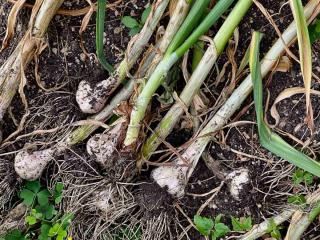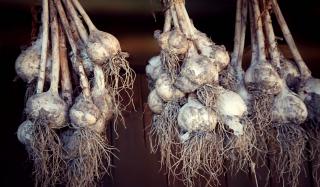

Garlic is a perennial vegetable spice, a must-have in the vegetable patch. It craves sun.
Key Garlic facts
Name – Allium sativum
Family – Alliaceae
Height – 12 to 40 in (30 to 100 cm)
Climate – temperate
Exposure – full sun
Garlic bulbs are a common condiment in cooking. Their taste and spicing abilities are unmatched and beloved by many!
First of all, purchase strands of garlic that are certified to be with neither nematodes (roundworm) nor virus.
 When selecting the cloves, plant those that are around the outside of the head instead of the inside ones because they are larger and more hardy.
When selecting the cloves, plant those that are around the outside of the head instead of the inside ones because they are larger and more hardy.
You can use store-bought cloves intended for cooking, if the label says they are virus-free.
Start with digging one or more furrows an inch (a couple centimeters) deep.
Place furrows at a distance of around 8 inches (20 cm).
Be careful! Garlic doesn’t like waterlogged soil. If this is the case, amend your soil with sand.
Traditionally, white and purple garlic is planted in fall and pink garlic is planted at the very beginning of spring.
It is best to plant cloves (small secondary bulbs) in fall (October-November) if your soil is well drained, otherwise wait for the beginning of spring.
Pink garlic is planted at the end of winter in climates that are mild, and at the beginning of spring in other areas.
Pink garlic is an early variety, ready for harvest in spring.
Garlic LOVES growing together with red beet, chamomile, carrot, celery, strawberry plant, lettuce, leek and tomato.
Garlic DREADS sharing space with asparagus, cabbage, broad bean, bean and pea plants.
Garlic is quite easy to care for and requires very little care as it grows. The following best practices will help you have a better harvest, though.
 When the young plants start growing out of the soil, clean around them on a regular basis to remove weeds. Also, help water and air penetrate the ground by breaking up the soil crust.
When the young plants start growing out of the soil, clean around them on a regular basis to remove weeds. Also, help water and air penetrate the ground by breaking up the soil crust.
Another summer visitor will lay its eggs on garlic stems… and caterpillars will start chomping down on them as soon as they hatch! The culprit is a large white butterfly.
First leaves appear around 1 month after sowing. They’ll get more numerous as cloves form underground.
 When bulbs reach an honorable size and seem to be well-formed (June to July depending on the chosen variety), that is the time to harvest your garlic! Pull one or two out to tell, you can’t really know until you unearth them.
When bulbs reach an honorable size and seem to be well-formed (June to July depending on the chosen variety), that is the time to harvest your garlic! Pull one or two out to tell, you can’t really know until you unearth them.
Before harvesting, remember to tie stems that are beginning to turn yellow into a knot. This stops them from growing and forces sap and nutrients to gather in the head of garlic, making it fatter.
 After that, clean it and keep it in a dry, ventilated and rather cool spot.
After that, clean it and keep it in a dry, ventilated and rather cool spot.
Note that it is also possible to harvest garlic in spring when still green, usually in May, and to eat bulbs and leaves alike. Bulbs won’t keep so it’s for immediate consumption.
 Native to Central Asia, garlic is a condiment with long, flat leaves that shoot up from the base and produces white to light pink flowers.
Native to Central Asia, garlic is a condiment with long, flat leaves that shoot up from the base and produces white to light pink flowers.
It has been used for millennia to spice up dishes in most parts of the world.
It has a capacity to add taste to many dishes. Moreover, it is an antiseptic, stimulating and even boasts aphrodisiac properties, nothing less!
Garlic is part of the same family as shallot, leek and onion.
 Garlic has many health benefits and therapeutic properties and it has been used for a long time to cure many ailments.
Garlic has many health benefits and therapeutic properties and it has been used for a long time to cure many ailments.
Indeed, garlic is both tonic and antiseptic, it helps fight hypertension and rheumatism. It even joins in on fighting cancer.
It also is an ally in fighting certain garden diseases such as peach leaf curl, either by planting it nearby or used in a garlic decoction.
In spring, remove weeds around garlic because feeling crowded really slows its growth.